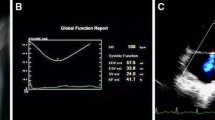Abstract
Objective
To assess left ventricular function in patients presenting with pulmonary edema following scorpion envenomation.
Design
Cohort study.Setting: Medical intensive care unit of a teaching hospital.Patients: Nine consecutive adult patients stung byAndroctonus australis and presenting with pulmonary edema entered the study. Fourteen normal volunteers comprised the control group.
Interventions
Upon admission, all patients had right heart catheterization and, within the first 8 h, a Doppler echocardiographic study. Results of Doppler echocardiographic studies were compared to those of controls.
Measurements and results
Usual hemodynamic information (heart and vascular pressures, derived data and tissue oxygenation parameters), left ventricular dimensions and indicators of systolic function, and Doppler-derived parameters of left ventricular filling and diastolic function were obtained upon admission. Serial echocardiographic measurements were repeated daily until full clinical recovery (eight patients) or death (one patient). All patients had a hemodynamic profile of acute congestive heart failure (mean PAOP=24±2 mmHg; mean SVI=22±7 ml/m2; mean CI=2.5±0.5 l/min/m2). However, SVR were not increased (mean=22±3 U/m2). Left ventricle was hypokinetic in all patients with transient mitral regurgitation present in five patients. Left ventricular systolic function was markedly depressed (FS=12±6%; EF=26±12%). An associated diastolic dysfunction is suggested by Doppler records of mitral inflow. Left ventricular systolic function evolved toward normalization within 6±2 days preceded by full clinical recovery.
Conclusions
These data suggest that pulmonary edema in scorpion envenomation is of hemodynamic origin and is related to a severe and prominent impairment of left ventricular systolic function.
Similar content being viewed by others
References
Gueron M, Yaron R (1970) Cardiovascular manifestations of severe scorption sting. Clinicopathologic correlations. Chest 57:156–162
Gueron M, Ilia R, Sofer S (1992) The cardiovascular system after scorpion envenomation. A review. Clin Toxicol 30:245–258
Abroug F, Boujdaria R, Belghith M, Nouira S, Bouchoucha S (1991) Cardiac dysfunction and pulmonary edema following scorpion envenomation. Chest 100:1057–1059
Tarasiuk A, Sofer S, Huberfelo S, Scharf M (1994) Hemodynamic effects following injection of venom from the scorpionLeirus quinquestriatus. J Crit Care 9:134–140
Gueron M, Adolph RJ, Grupp IL, Gabel M, Grupp G, Fowler NO (1980) Hemodynamic and myocardial consequences of scorpion venom. Am J Cardiol 45:979–986
Ismail M, Ghazal A, El Fakahani EE (1980) Cardiovascular effects of venom from the scorpionButhus occiotanus amoreux. Toxicon 18:327–337
Yarom R, Braun K (1970) Cardiovascular effects of scorpion venom: morphological changes in the myocardium. Toxicology 8:41–46
Rahav G, Weiss AT (1990) Scorption-sting-induced pulmonary edema: scintigraphic evidence of cardiac dysfunction. Chest 97:1478–1480
Amaral CFS, De Rezendo NA, Freire-Maia L (1993) Acute pulmonary edema afterTityus serrulatus scorpion sting in children. Am J Cardiol 71:242–245
Amaral CFS, Lopes JA, Magalhares RA, De Rezendo NA (1991) Electrocardiographic, enzymatic and echocardiographic evidence of myocardial damage afterTityus serrulatus scorpion poisoning. Am J Cardiol 67: 655–657
Gueron M, Margulis G, Sofer S (1990) Echocardiographic and radionuclide angiographic observations following scorpion envenomation byLeirus quinquestriatus. Toxicon 28:1005–1009
Hering SE, Jurca M, Vichi FL, Azevdo-Marques HM, Cupo P (1993) Reversible cardiomypathy in patients with severe scorpion envenoming byTityus serrulatus: evolution of enzymatic, electrocardiographic and echocardiographic alterations. Ann Trop Pediatr 13:173–182
Kumar EB, Soomro RS, Al Hamdani A, El Shimy N (1992) Scorpion venom cardiomyopathy. Am Heart J 123: 725–729
Teichholz LE, Kreulen T, Herman MY, Gorlin R (1976) Problems in echographic volume determinations: echocardiographic-angiographic volume correlations in the presence or absence of asynergy. Am J Cardiol 37:711
Gueron M, Stern J, Cohen W (1967) Severe myocardial damage and heart failure in scorpion sting. Report of five cases. Am J Cardiol 19:719–726
Poon-King T (1963) Myocarditis from scorpion stings. BMJ 1:374–377
Appleton CP, Hatle LK, Popp RL (1988) Relation of transmitral velocity patterns to left ventricular diastolic function: new insights from combined hemodynamic and Doppler echocardiographic study. J Am Coll Cardiol 12:426–440
Quinones MA (1993) Doppler assessment of left ventricular diastolic function. In: Nanda CN (ed) Doppler echocardiography, 2nd edn. Lea and Febiger, Philadelphia, pp 197–215
Nishimura RA, Abel MD, Hatle LK, Tajik AJ (1989) Assessment of diastolic function of the heart: background and current applications of Doppler echocardiography. Part 2. Clinical studies. Mayo Clin Proc 64:181–204
Rossvol O, Hatle LK (1993) Pulmonary venous flow velocities recorded by transthoracic Doppler ultrasound: relation to left ventricular diastolic pressures. J Am Coll Cardiol 21:1687–1696
Brand A, Keren A, Kerem E, Reifen RM, Branski D (1988) Myocardial damage after a scorpion sting: longterm echocardiographic follow-up. Pediatr Cardiol 9:59–61
Sofer S, Gueron M (1990) Vasodilators and hypertensive encephalopathy following scorpion envenomation in children. Chest 97:118–120
Bawaskar HS, Bawaskar PH (1987) Prazosin for vasodilator treatment of acute pulmonary oedema due to scorpion sting. Ann Tropical Med Parasitol 81:719–723
Gueron M, Ilia R, Shahak E, Sofer S (1992) Renin and aldosterone levels and hypertension following envenomation in humans by the yellow scorpionLeirus quinquestriatus. Toxicon 30:765–767
Sofer S, Gueron M (1988) Respiratory failure in children following envenomation by the scorptionLeirus quinquestriatus. Hemodynamic and neurological aspects. Toxicon 26:931–939
Bawaskar HS, Bawaskar PH (1992) Management of the cardiovascular manifestations of poisoning by the indian red scorption (Mesobuthus tamalus). Br Heart J 68:478–480
Gueron M, Sofer S (1990) Vasodilators and calcium blocking agents in treatment of cardiovascular manifestations of human scorpion envenomation. Toxicon 28:127–128
Gueron M, Ovsyshcher I (1987) What is the treatment for the cardiovascular manifestations of scorpion envenomation? Toxicon 25:121–124
Author information
Authors and Affiliations
Rights and permissions
About this article
Cite this article
Abroug, F., Ayari, M., Nouira, S. et al. Assessment of left ventricular function in severe scorpion envenomation: Combined hemodynamic and echo-Doppler study. Intensive Care Med 21, 629–635 (1995). https://doi.org/10.1007/BF01711539
Received:
Accepted:
Issue Date:
DOI: https://doi.org/10.1007/BF01711539




